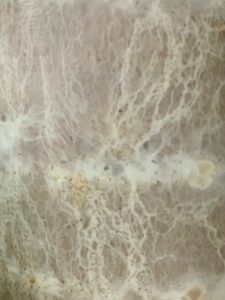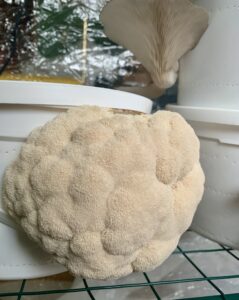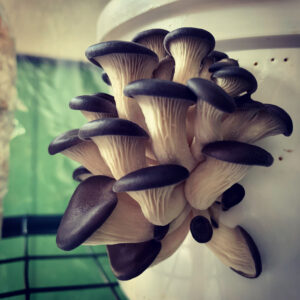Final report for FNC22-1335
Project Information
Small scale mushroom production. We've spent about three years experimenting with various low-impact growing methods and have always been focused on zero- or minimal-waste techniques.
- Growing mushrooms commercially without a lot of energy, infrastructure, and single-use plastic is very challenging. Mushroom growers rely on autoclavable polypropylene bags to contain spawn (e.g grain) and bulk substrate (e.g. sawdust) during sterilization. Once the mushrooms are harvested from the bags, the plastic is sent to the landfill. Additionally, the sterilization process is cumbersome and energy-intensive requiring high heat and vessels that can withstand 15 pounds of pressure for a substantial amount of time. A company in North Carolina, Mycovations, developed a technique to eliminate one of these unsustainable barriers for small-scale mushroom farmers: they found that vinegar can be used to pasteurize hardwood fuel pellets, eliminating the on-farm need for sustained heat and pressure in growing popular culinary mushrooms like Oyster and Lion's Mane. However, their method still relies on the use of new plastic bags.
- I will explore the feasibility of replacing single-use bags with reusable buckets using Mycovation's vinegar pasteurization technique. All spent substrate will be composted on-site and used to grow secondary-decomposer mushrooms and enhance soil health. The goal is to make mushroom growing as regenerative and accessible to local farmers as possible while reducing the amount of single-use plastic used in production. The Mycovation's technique works because the pasteurized substrate is packed into plastic bags that have been perforated at precise intervals to allow the mycelium to "run" very quickly (due to adequate access to oxygen) while limiting the risk of contamination. I will research the feasibility of simply replacing the plastic bags with gallon-sized buckets that have been similarly perforated and then measuring the yield against input factors, specifically the time spent perforating buckets and cleaning them for re-use.
- This experiment was concluded in the early summer of 2022 when three factors indicated its unfeasibility for commercial growers:
- Yield: consistently less than desired (average biological efficiency was 50%, or 1 pound of mushrooms harvested from 2 pounds of substrate)
- Time: Far too much time required for making the hole-punched buckets and cleaning them for re-use, specifically because the small holes get clogged with hardened mycelium and are very difficult to clean effectively.
- Seasonal contamination: Higher temperatures encouraged more contamination in the pasteurized substrate, so much so that the method became impossible without climate control once summer arrived.
- Develop a technique for bucket/jar growing that produces reliable and consistent results. Buckets will be used for pasteurized bulk substrate and glass jars will be used for grain spawn made on-site.
- Research the time, cost, and yield comparison for Oyster and Lion's Mane mushrooms grown in single-use plastic versus reusable plastic buckets.
- Share the process with area farmers who may wish to add mushrooms to their operation through field days, social media, and info sheets.
Research
- Purchase supplies: I purchased everything I needed for the project in bulk (rye grain, liquid culture inoculants, hard wood fuel pellets, vinegar, canning jars, and plastic buckets)
- Expand the liquid culture using a honey broth (described by Peter McCoy in Radical Mycology and other sources). This saves on costs because you can bulk up the liquid culture in small canning jars and have enough to produce all of your own grain spawn.
- Inoculate rye grain with honey broth mycelium in quart-size jars with modified lids to make grain spawn.
- Perforate gallon-size plastic buckets with three rings of tack-size holes all the way around the circumference of the bucket (first ring is about 1 inch from the bottom of the bucket, the second ring is directly in the middle, and the third ring is about 1.5 inches down from the top of the bucket). Holes are spaced about 1 cm apart.
- Once grain was fully myceliated, I hydrated/pasteurized hardwood fuel pellets with vinegar-water at a rate of 100ml vinegar per 10 pounds of pellets (with an equal amount of water to the weight of pellets, so 10 pounds of water per 10 pounds of pellets). For one gallon buckets, I needed two pounds of dry pellets per bucket.
- Then, I layered the hydrated pellets with the grain spawn. This is key: The grain spawn is layered only at the perforated rings, NOT mixed into the hydrated wood pellets. I used between 0.5 and one pound of grain spawn per bucket.
- Incubate buckets in a clean, dark space.
- Within 1.5-2 weeks, the buckets were ready to fruit and were placed in a cool, moist fruiting tent with adequate air flow.
- Harvest mushrooms and weigh the clusters.
- Either compost the bucket if it shows signs of contamination, or leave it for a second fruiting. I found that successful fruiting was not worth the risk of contamination and usually did not add significantly to the yield.



I concluded that this method is not feasible for commercial growers despite being relatively successful in producing good-quality mushrooms without sterilization or single-use plastic. It would be ideal for home-growers but requires far too much time, especially in the cleaning phase, to make sense for commercial operations. Yields were decent for a person or family wanting to produce their own mushrooms without adding to landfill waste, but at about 50% biological efficiency and a high input of time, this method does not make sense for a market grower. The greatest input was time - first spent in perforating the plastic buckets and then spent cleaning them for reuse. The tiny holes required to make this method work are very difficult to clean adequately as the mycelium and its exudates harden inside of the holes and become major contamination risks. The vinegar-tek pasteurization method certainly has its benefits and without the excessive time input (achieved by using single-use plastic bags) it may be feasible for commercial growers as a relatively cheap and low-impact growing method. Further research/experimentation could be done in producing a cleaning tool for the buckets; I was picturing a spinning brush with bristles that poke through the holes as the bucket spins.
Educational & Outreach Activities
Participation Summary:
If this method was more successful, I planned on having on-farm and online demos. However, at this point, I do not think it is feasible for market growers and have not produced any educational content describing the method besides one social media post showing the bucket technique and describing its low-impact benefits.
Learning Outcomes
With this grant, I learned that the method under investigation is ideal for home-scale production but is not feasible for market farmers. There were three significant issues that arose when I attempted to scale up production using reusable plastic buckets in place of plastic bags for the vinegar-tek method described in my proposal:
- Yield: Yields were consistently less than what most commercial growers expect with a biological efficiency averaging around 50% (1 pound of mushrooms harvested from 2 pounds of dry substrate).
- Time: The small holes that are poked around the circumference of the bucket to enable a quick run of the mycelium and prevent pathogens are nearly impossible to clean efficiently because the mycelium hardens inside of them and requires a sharp utensil to poke out during cleaning. On a small scale (1-10 buckets) this can be done with the help of a small nail or tack; but once I scaled up, the time required to ensure proper sanitation was no longer feasible, especially given smaller yields.
- This method worked very well during the colder months (October-April) and I experienced very little contamination with successful fruiting on nearly every bucket, however once the temperature started rising in the later spring, I experienced far more contamination and had to compost a large percentage of the buckets. By early-summer I had given up on this method because the contamination rate was too high without climate control.
Project Outcomes
N/A
N/A